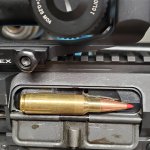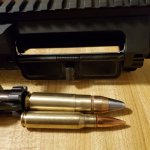If you read through some of the Army Ordnance/ARDEC studies in the 1950-1960ss on barrel metallurgy for the M60 program, you will see a lot of familiar processes and linings that have been marketed as new wizardry in the past 20 years. They tried all of that, including NiB and various nitriding processes, and ended up going to Stellite liners for M60 barrels, because they were experiencing a lot of early bore erosion and loss of performance.
The Stellite liner is actually another barrel that gets press-fit into the barrel, then a barrel collar with the rest of the chamber gets threaded on and torqued hard into place, followed by the barrel extension being torqued on. For those of us who remember the M60, you might recall that seam on the barrel in front of the extension flange. That’s why.
Notice that the Stellite liner starts at the freebore in front of the case mouth, to help mitigate the blast of solid prepellant being converted and flowing through the throat during the conversion and early conflagration.
For general issue service rifles, it’s not something you would be able to scale in production.
It would be very prohibitive even for limited issue.
With the .224” bore, we’re at the max right now with the case capacity of 5.56, which has surprisingly-good barrel life with hard chrome-lined barrels. It all depends on the shoot schedule you run them through. In some units, that means they toast barrels every 2 weeks, while in others, they last 12-14 years. Some shoot a lot, and some don’t.
The more back-end capacity and pressure we apply to anything with a .224” bore, the more throat erosion we will see. It’s as simple as that. This is why I think the .224” bore needs to slowly go away and open up to .257” at a minimum. 6mm/.243” is not much different in that regard than .224” and builds a lot of pressure due to limited bore volume. Most everyone with .243” bores that actually shoots a lot is looking for their next barrel.
If you read through the SCHV concepts, history, and studies, they wanted high impact velocities both for tissue destruction and helmet perforation. The 222 Remington already met the requirements, but Army Ordnance inserted itself and kept moving the goal posts for the steel perforation tests until it “only” penetrated one side of an M1 steel helmet, but didn’t go out the other. They then declared it unsuitable and washed their hands of it. Stoner asked Remington if they could increase the case capacity a little by blowing the shoulder forward (222 Rem has a lot of neck length available), and then had them reduce the projectile weight from 68gr to 55gr, and added a boat tail. This is where the 222 Remington Special came from, and was later type-classified as 5.56x45mm M193.

They were able to then increase the muzzle velocity and still retain enough impact speed to perforate the steel helmet at the new goal post placement to satisfy the silly requirement, but I think Stoner felt Army Ordnance was going to dismiss it either way. He still continued to do his due diligence as a lead designer at ArmaLite.
Army Ordnance then began sending different cartridge drawings to ArmaLite to add case capacity in order to get more performance from the rifle, some of them very good ideas (like the 25 Remington-based cartridge), but they were designed to keep ArmaLite running around in circles chasing their tails and bleeding money while Army Ordnance pushed the M-14 development to a key milestone for production so that the AR-15 could be side-lined and forgotten. Each time a new cartridge was designed, then needed to design new magazines and increase the receiver set, bolt, and barrel extension sizes slightly.
Fairchild Aircraft Company looked at this small arms division of theirs, and saw ArmaLite was eating up budget without any contracts, so Cooper-McDonald Co. arranged for the sale of the Stoner patents and tool room samples of AR-10s and AR-15s to Colt in the summer of 1959. Colt began tooling up for the AR-10A, which was a smaller frame version of the original AR-10s with several updates from the AR-15 that would make it easier to produce.
McDonald began touring around South Pacific and Southeast Asian countries in 1959 to show them the AR-10 and AR-15 prototypes, doing shooting demos, and found that several nations’ militaries and police were ready to order AR-15s on the spot, not the AR-10.
He sent an urgent wire message back to Colt in Hartford, CT, telling them to tool-up for AR-15s instead of AR-10s so they could start filling orders. Colt started manufacturing the Model 601 AR-15 in December of 1959, and Cooper-McDonald got one of the original Colt 601s, serial number 106 (the 6th 601 off the line). McDonald took this to Dick Buetelle’s (CEO of Fairchild-Hiller Corp at the time) 4th of July birthday BBQ, where USAF Vice Chief of Staff, Curtis LeMay was attending.
LeMay was looking for a new rifle for his elite SPs, who would guard the US’s nuclear sites and nuclear bomber bases. They out out watermelons for him to shoot, and the rest is history. LeMay’s requests at the Pentagon were taken far more seriously than pretty much anything the US Army had to say, so this is why Army Ordnance was bewildered when their elimination of the AR-15 was overridden without comment and they were ordered to begin type-classification of the rifle.
I do feel that those tail-chasing cartridge configurations would have yielded a better intermediate cartridge, if it had been in .257”, which was not being considered at the time. A shorter .257” bore cartridge based on the 25 Remington would have been the way to go, which takes you up in case capacity and makes for a great carbine, DM, Light Sniper, and LMG cartridge. The 5.56 is a bit light for those applications once you start increasing the engagement distances.

















